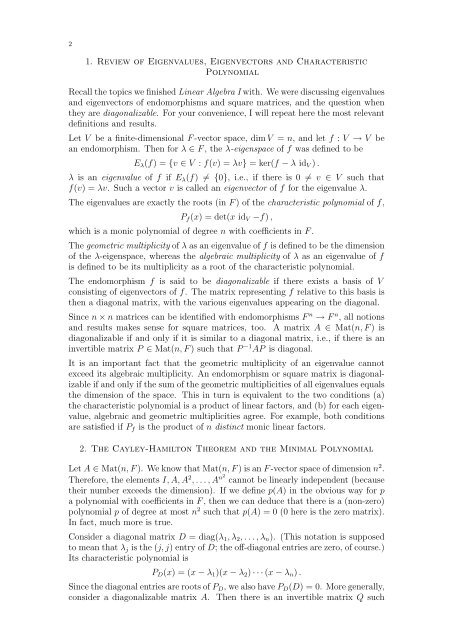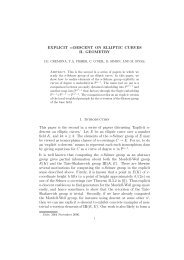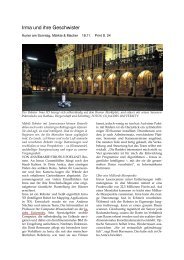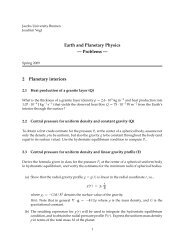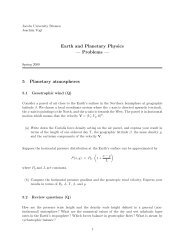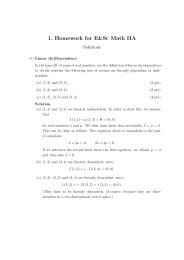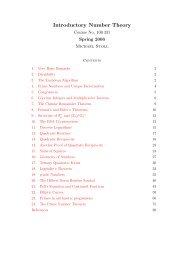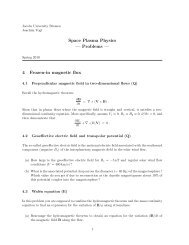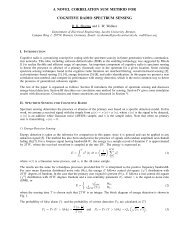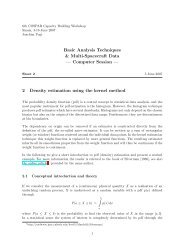Linear Algebra II (pdf, 500 kB)
Linear Algebra II (pdf, 500 kB)
Linear Algebra II (pdf, 500 kB)
Create successful ePaper yourself
Turn your PDF publications into a flip-book with our unique Google optimized e-Paper software.
2<br />
1. Review of Eigenvalues, Eigenvectors and Characteristic<br />
Polynomial<br />
Recall the topics we finished <strong>Linear</strong> <strong>Algebra</strong> I with. We were discussing eigenvalues<br />
and eigenvectors of endomorphisms and square matrices, and the question when<br />
they are diagonalizable. For your convenience, I will repeat here the most relevant<br />
definitions and results.<br />
Let V be a finite-dimensional F -vector space, dim V = n, and let f : V → V be<br />
an endomorphism. Then for λ ∈ F , the λ-eigenspace of f was defined to be<br />
Eλ(f) = {v ∈ V : f(v) = λv} = ker(f − λ idV ) .<br />
λ is an eigenvalue of f if Eλ(f) = {0}, i.e., if there is 0 = v ∈ V such that<br />
f(v) = λv. Such a vector v is called an eigenvector of f for the eigenvalue λ.<br />
The eigenvalues are exactly the roots (in F ) of the characteristic polynomial of f,<br />
Pf(x) = det(x idV −f) ,<br />
which is a monic polynomial of degree n with coefficients in F .<br />
The geometric multiplicity of λ as an eigenvalue of f is defined to be the dimension<br />
of the λ-eigenspace, whereas the algebraic multiplicity of λ as an eigenvalue of f<br />
is defined to be its multiplicity as a root of the characteristic polynomial.<br />
The endomorphism f is said to be diagonalizable if there exists a basis of V<br />
consisting of eigenvectors of f. The matrix representing f relative to this basis is<br />
then a diagonal matrix, with the various eigenvalues appearing on the diagonal.<br />
Since n × n matrices can be identified with endomorphisms F n → F n , all notions<br />
and results makes sense for square matrices, too. A matrix A ∈ Mat(n, F ) is<br />
diagonalizable if and only if it is similar to a diagonal matrix, i.e., if there is an<br />
invertible matrix P ∈ Mat(n, F ) such that P −1 AP is diagonal.<br />
It is an important fact that the geometric multiplicity of an eigenvalue cannot<br />
exceed its algebraic multiplicity. An endomorphism or square matrix is diagonalizable<br />
if and only if the sum of the geometric multiplicities of all eigenvalues equals<br />
the dimension of the space. This in turn is equivalent to the two conditions (a)<br />
the characteristic polynomial is a product of linear factors, and (b) for each eigenvalue,<br />
algebraic and geometric multiplicities agree. For example, both conditions<br />
are satisfied if Pf is the product of n distinct monic linear factors.<br />
2. The Cayley-Hamilton Theorem and the Minimal Polynomial<br />
Let A ∈ Mat(n, F ). We know that Mat(n, F ) is an F -vector space of dimension n2 .<br />
Therefore, the elements I, A, A2 , . . . , An2 cannot be linearly independent (because<br />
their number exceeds the dimension). If we define p(A) in the obvious way for p<br />
a polynomial with coefficients in F , then we can deduce that there is a (non-zero)<br />
polynomial p of degree at most n2 such that p(A) = 0 (0 here is the zero matrix).<br />
In fact, much more is true.<br />
Consider a diagonal matrix D = diag(λ1, λ2, . . . , λn). (This notation is supposed<br />
to mean that λj is the (j, j) entry of D; the off-diagonal entries are zero, of course.)<br />
Its characteristic polynomial is<br />
PD(x) = (x − λ1)(x − λ2) · · · (x − λn) .<br />
Since the diagonal entries are roots of PD, we also have PD(D) = 0. More generally,<br />
consider a diagonalizable matrix A. Then there is an invertible matrix Q such


